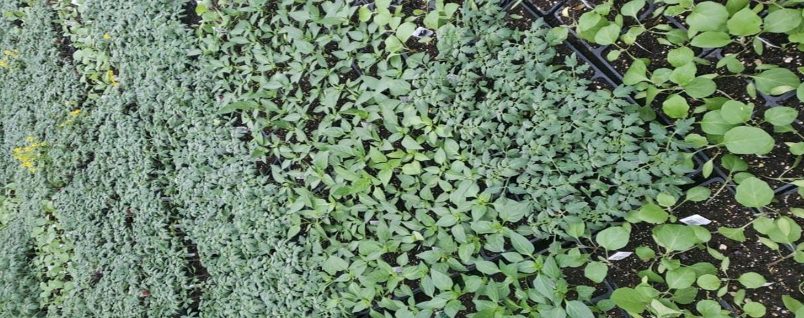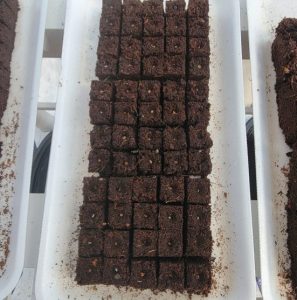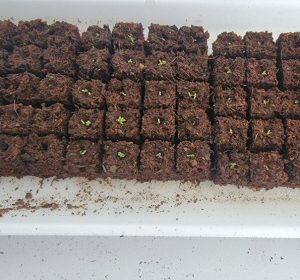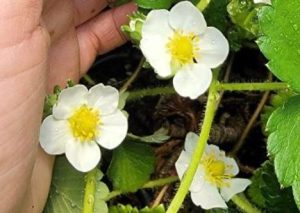What’s Happening on the Farm in Early Spring?

“I know the seed may seem small and insignificant, but it’s not what it is, It’s about what it can become.” -The Lorax.
This is one of my favorite stories because it shows how amazing the living world around you is. As a farmer, my job is to take an active role and help grow many of the fruits and veggies you see everyday. My name is Rebecca and together with my brother Charles we run Stoecker Farms Produce. We are actually the 4th generation of our family to do so. Our original family farm was in Middle River, MD and we currently farm in White Hall, MD. We sell most of our produce at local farmer’s markets in Baltimore City and Carroll County. Did you know there are over 100 farmer’s markets in the state of Maryland? That means there might just be one close to you.
 Before we can head to the farmer’s market, even before we can start picking delicious veggies and fruits we need to work with our seeds. We start many of our seeds in our greenhouse. But you could start seeds anywhere, in your basement with extra lighting or even on your kitchen table. For our plants we wet our potting soil on our mixing table and fill our trays. Some of the seeds we can use a vacuum seeder to line up the seeds to the tray slots, while others we hand seed.
Before we can head to the farmer’s market, even before we can start picking delicious veggies and fruits we need to work with our seeds. We start many of our seeds in our greenhouse. But you could start seeds anywhere, in your basement with extra lighting or even on your kitchen table. For our plants we wet our potting soil on our mixing table and fill our trays. Some of the seeds we can use a vacuum seeder to line up the seeds to the tray slots, while others we hand seed.
This year we tried something new with our flower starters. Soil blocking allows you to create small or large soil blocks for your seeds. You mix up a heavily dampened the mixture of nutrients, coco fiber or peat moss and compost. They are then placed on flat trays using a metal tool that collects the soil inside of it and creates the blocks you see below. This allows the plants to have a better air flow and helps grow a better and strong root system.
Soil blocking can be done easily in your home too

1. Gather up any flat trays you have, they shouldn’t have any drainage holes and need to hold water.
2. Use a large container to mix 16 cups of peat moss and 2 cups of compost and a 1⁄2 cup of seed starting mix to get your nutrients.*
3. Mix it together with warm water until consistency.
4. Next you can use your hands to make a small ball with the mixture or use a tin can to create a more uniform shape, just like cutting biscuits or play doh.
5. Then place your seeds gently into the top of your soil blocks on your trays.
6. Mist or water the bottom up so your block stays together
7.Watch your seeds grow.

While we start our seeds in the greenhouse it is important to maintain good lighting, watering and warmth. During the day a greenhouse heats up very easily, at night we use electric heaters, warming mats and even frost cloth depending on the plants needs. Maintaining a consistent temperature helps our seeds grow to the best of their ability and will give us healthy plants to put out once our last frost dates have passed.
In Maryland our last frost date is Mother’s day. It is important to pay close attention to the weather during these spring months. If you put a plant out too early like a tomato and we had a frost on a cold night you could lose that tomato plant and all of the bushels of delicious tomatoes it would have produced. Plants like strawberries that have been in the ground over winter can be uncovered or recovered with straw or frost cloth so they can enjoy the warm days and still be protected from those chilly nights.
Meet Rebecca & Charles of Stoecker Farms Produce


We look forward to speaking with you next month as we begin laying plastic mulch and start planting our veggies in the fields. We also head to the farmer’s market for the first time this new season with veggie, flower and herb plants for our patrons to purchase for their own gardens.
DID YOU KNOW?
Many of the yummy produce we like to eat starts out as a flower. Can you guess what these flowers are going to become? Find out in our next blog. See you soon!

